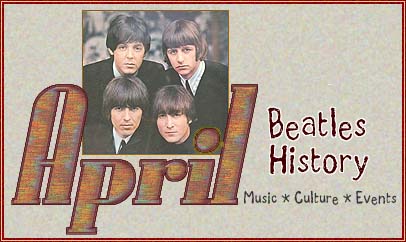 History offers History offers
a chance
to truly
understand
how the past
impacts the now.
Follow our
daily timelime
of historical
events to
discover the
role The Beatles
played in changing
the modern world.
THE FOLLOWING EVENTS TOOK PLACE ON APRIL 10
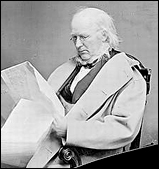 1516--The first ghetto is created, as Jews are compelled to live in a specific area of Venice. 1516--The first ghetto is created, as Jews are compelled to live in a specific area of Venice.
1790--The US Patent system is established.
1841--The New York Tribune begins publishing under editor Horace Greeley.
1866--The American Society for Prevention of Cruelty to Animals (ASPCA) is established.
1930--Synthetic rubber goes into production.
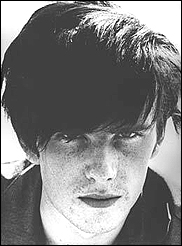 1956--Leo Fender patents the Stratocaster guitar. 1956--Leo Fender patents the Stratocaster guitar.
1961--The Beatles perform at the Top Ten Club, Reeperbahn, Hamburg, West Germany.
1962--Stu Sutcliffe, former Beatle and perhaps John Lennon's closest friend (now living in Hamburg, West Germany), dies from a brain hemorrhage at the age of 21. Sutcliffe met Lennon when the two were at art school and he introduced John to modern art and literature, while Lennon introduced Stu to rock and roll. He joined The Beatles and played bass (Paul McCartney was on rhythm guitar at the time). He left the band in 1961 to resume painting, because his chronic headaches were getting too severe. By then he (and his German girlfriend, Astrid Kirchherr) had given The Beatles the look that would soon charm the world: their trademark shaggy, brushed-forward hairstyles.
1963--The Beatles perform at the Majestic Ballroom, Birkenhead. This will be their final appearance at this venue.
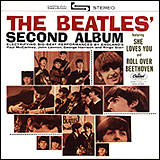 1963--Before the show at Birkenhead, John Lennon visits his wife, Cynthia, at Sefton General Hospital and sees his infant son, Julian, for the first time. 1963--Before the show at Birkenhead, John Lennon visits his wife, Cynthia, at Sefton General Hospital and sees his infant son, Julian, for the first time.
1964--US release of The Beatles' LP The Beatles Second Album (Capitol). Songs: Roll Over Beethoven, Thank You Girl, You Really Got a Hold On Me, Devil In Her Heart, Money, You Can't Do That, Long Tall Sally, I Call Your Name, Please Mr. Postman, I'll Get You, and She Loves You. 55 weeks on Billboard chart; highest position #1.
1964--The Beatles filming at Twickenham Film Studios for "A Hard Day's Night." Shooting the "production office" sequence.
1965--The Beatles record their final performance for the BBC television program "Top of the Pops." They lip-sync to the songs from their latest single, Ticket to Ride and Yes It Is. For the first time, The Beatles wear the fawn-colored jackets that they will also wear for their famous Shea Stadium concert. A portion of the Ticket to Ride video is included in the May 22 broadcast of the popular British sci-fi series "Doctor Who."
1965--Sid Bernstein phones Brian Epstein at the Waldorf Towers, then visits him to pay The Beatles $100,000 in advance for the Shea Stadium concert.
1967--Paul McCartney visits a Beach Boys recording session and is said to have loaned his production assistance (chewing on vegetables) to the track "Vegetables" for the controversial Smile LP.
1970--UK release of the soundtrack LP "The Magic Christian." Ringo Starr acted in the movie, and the album contains a bit of Ringo's dialogue from the film. The film's theme song, Come and Get It, was composed by Paul McCartney. McCartney produced the group Badfinger's performance of the song for the soundtrack.
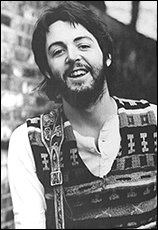 1970--Paul McCartney announces his resignation from The Beatles, one week before the UK release of his solo album McCartney. The world is shocked. John Lennon, who had kept his much-earlier decision to leave The Beatles quiet for the sake of the others, is furious, feeling (justifiably) betrayed by McCartney's pre-emptive strike, which obviously was aimed at obtaining maximum momentum for McCartney himself. When a reporter calls Lennon for a comment upon McCartney's resignation, Lennon says, "...Paul hasn't left. I sacked him." Things get worse when McCartney issues a printed "self-interview" with advance promotional copies of the McCartney album. Some of the answers to the interview questions come across as petty and self-serving. Derek Taylor’s press release read as follows: “Ringo and John and George and Paul are alive and well and full of hope. The Beatles are alive and well and the beat goes on, the beat goes on.” 1970--Paul McCartney announces his resignation from The Beatles, one week before the UK release of his solo album McCartney. The world is shocked. John Lennon, who had kept his much-earlier decision to leave The Beatles quiet for the sake of the others, is furious, feeling (justifiably) betrayed by McCartney's pre-emptive strike, which obviously was aimed at obtaining maximum momentum for McCartney himself. When a reporter calls Lennon for a comment upon McCartney's resignation, Lennon says, "...Paul hasn't left. I sacked him." Things get worse when McCartney issues a printed "self-interview" with advance promotional copies of the McCartney album. Some of the answers to the interview questions come across as petty and self-serving. Derek Taylor’s press release read as follows: “Ringo and John and George and Paul are alive and well and full of hope. The Beatles are alive and well and the beat goes on, the beat goes on.”
1972--The US, USSR and 70 other nations agree to ban biological weapons.
1973--John Lennon and Ringo Starr attend a private party for Daniel Ellsberg, who has become a national figure after his involvement with the “Pentagon Papers” revelations. Clearly Lennon's interest in American politics is still strong, despite his ongoing problems with immigration.
 1974--Just two weeks after moving in, John Lennon and May Pang again pack up and move out of their rented beach house into a new rented premises; this time a house nearby in Santa Monica that once belonged to Peter Lawford. The rent on this Pacific Coast Highway house is $5,000 a month. Two weeks later, John and May will return to New York. 1974--Just two weeks after moving in, John Lennon and May Pang again pack up and move out of their rented beach house into a new rented premises; this time a house nearby in Santa Monica that once belonged to Peter Lawford. The rent on this Pacific Coast Highway house is $5,000 a month. Two weeks later, John and May will return to New York.
1975--Pre-recorded interviews with John Lennon, recorded in New York to promote the album Rock 'n' Roll, form the basis of a Capital Radio special which airs tonight: “An Evening with John Lennon.”
1989--UK re-release of The Beatles' single Get Back / Don't Let Me Down (Parlophone). 20th anniversary reissue. Released as a regular single and also as a picture disc.
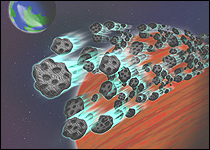 1990--The "Minor Planet Circular" announces a citation approving the naming of four new asteroids after The Beatles, that were discovered by astronomer B. A. Skiff. The asteroid names are (4147) Lennon, discovered 01-12-83; (4148) McCartney, discovered 07-11-83; (4149) Harrison, discovered 03-9-84; and (4150) Starr, discovered 08-31-84. To name an asteroid, the discoverer suggests a name of 16 characters or less. The suggested name is forwarded to the International Astronomical Union's Small Bodies Names Committee, along with a brief argument as to why that name is appropriate. The argument for naming asteroid 4150 after Ringo Starr went as follows: "He's a Liverpudlian of lively personality and deadpan humor who occasionally sat in as drummer with The Beatles during their early days in Hamburg." If an asteroid has not been named after ten years of its discovery, anyone can propose a name. The asteroid, Jerry Garcia, got its name from an email campaign started by a fan. Other asteroids have subsequently been named after musicians: Eric Clapton, Carlos Santana, Frank Zappa, Jean Michel Jarre, and Mike Oldfield. 1990--The "Minor Planet Circular" announces a citation approving the naming of four new asteroids after The Beatles, that were discovered by astronomer B. A. Skiff. The asteroid names are (4147) Lennon, discovered 01-12-83; (4148) McCartney, discovered 07-11-83; (4149) Harrison, discovered 03-9-84; and (4150) Starr, discovered 08-31-84. To name an asteroid, the discoverer suggests a name of 16 characters or less. The suggested name is forwarded to the International Astronomical Union's Small Bodies Names Committee, along with a brief argument as to why that name is appropriate. The argument for naming asteroid 4150 after Ringo Starr went as follows: "He's a Liverpudlian of lively personality and deadpan humor who occasionally sat in as drummer with The Beatles during their early days in Hamburg." If an asteroid has not been named after ten years of its discovery, anyone can propose a name. The asteroid, Jerry Garcia, got its name from an email campaign started by a fan. Other asteroids have subsequently been named after musicians: Eric Clapton, Carlos Santana, Frank Zappa, Jean Michel Jarre, and Mike Oldfield.
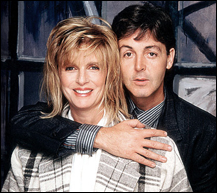 1995--New York City bans smoking in all restaurants that seat 35 or more. 1995--New York City bans smoking in all restaurants that seat 35 or more.
1998--The Northern Ireland peace talks conclude as negotiators reached a landmark settlement to end 30 years of bitter rivalries and bloody attacks.
1999--"Here, There and Everywhere: A Concert For Linda," a charity tribute concert for the late Linda McCartney, is held at the Royal Albert Hall in London. Among the perfomers are Paul McCartney, Chrissie Hynde of The Pretenders, Elvis Costello, Sinead O'Connor, and George Michael. Proceeds raised funds for animal rights causes.
For more day-by-day history go to HistoryUnlimited.net
|
 History offers
History offers


